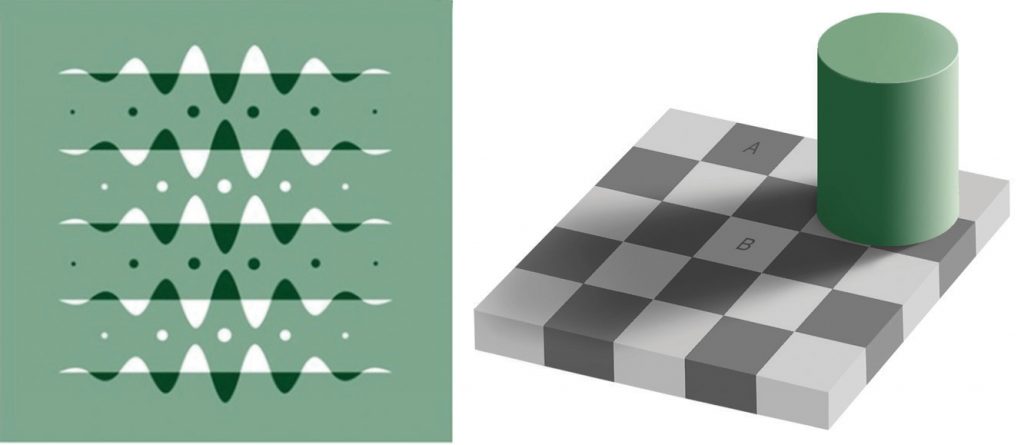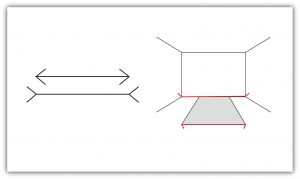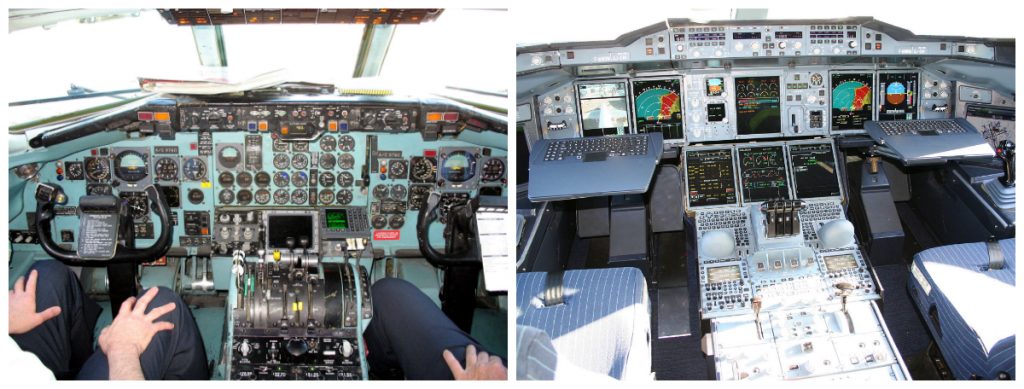5.5 Accuracy and Inaccuracy in Perception
Learning Objectives
- Describe how sensation and perception work together through sensory interaction, selective attention, sensory adaptation, and perceptual constancy.
- Explain of how our expectations may influence our perception, resulting in illusions and potentially inaccurate judgments.
The eyes, ears, nose, tongue, and skin sense the world around us. In some cases, our sense receptors perform preliminary information processing on the incoming data, but, by and large, we do not experience sensation. Instead, we experience the outcome of perception, which is the total package that the brain puts together from the pieces it receives through our senses and that the brain creates for us to experience. When we look at the face of a good friend or out the window at a view of the countryside, we do not just see a jumble of colours and shapes; we see, instead, an image of a friend or an image of a countryside (Goodale & Milner, 2006).
How the perceptual system interprets the environment
This meaning making involves the automatic operation of a variety of essential perceptual processes. One of these is sensory interaction, which is the working together of different senses to create experience. Sensory interaction is involved when taste, smell, and texture combine to create the flavour we experience in food. It is also involved when we enjoy a movie because of the way the images and the music work together.
Although you might think that we understand speech only through our sense of hearing, it turns out that the visual aspect of speech is also important. One example of sensory interaction is shown in the McGurk effect, which is an error in perception that occurs when we misperceive sounds because the audio and visual parts of the speech are mismatched.
You can experience the effect yourself by viewing the following YouTube link:
- Video: Try This Bizarre Audio Illusion! – BBC (BBC, 2010)
Other examples of sensory interaction include the experience of nausea, which occurs when the sensory information being received from the eyes and the body does not match information from the vestibular system (Flanagan, May, & Dobie, 2004), and synesthesia, which is an experience in which one sensation (e.g., hearing a sound) creates experiences in another (e.g., vision). Most people do not experience synesthesia, but those who do link their perceptions in unusual ways, for instance, by experiencing colour when they taste a particular food or by hearing sounds when they see certain objects (Ramachandran, Hubbard, Robertson, & Sagiv, 2005).
Illusions
Although our perception is very accurate, it is not perfect. Illusions occur when the perceptual processes that normally help us correctly perceive the world around us are fooled by a particular situation so that we see something that does not exist or that is incorrect. Optical illusions (see Figure 5.23) as a result of brightness constancy (left) and colour constancy (right) present two situations in which our normally accurate perceptions of visual constancy have been fooled.

Another well-known illusion is the Mueller-Lyer illusion (see Figure 5.24). The line segment in the bottom arrow looks longer to us than the one on the top, even though they are both actually the same length. It is likely that the illusion is, in part, the result of the failure of monocular depth cues; the bottom line looks like an edge that is normally farther away from us, whereas the top one looks like an edge that is normally closer.

The moon illusion refers to the fact that the moon is perceived to be about 50% larger when it is near the horizon than when it is seen overhead, despite the fact that in both cases the moon is the same size and casts the same size retinal image (see Figure 5.25). There have been several attempts to explain the moon illusion, such as the size-contrast theory, which argues that because the moon at the horizon is close to objects whose size we know (e.g., buildings, trees, etc.), we compare it to those know objects and thus perceive it to be larger. See Lloyd Kaufman and James Kaufman’s work (2009) for a further explanation of the complexities involved in understanding the moon illusion.

The Ponzo illusion operates on the same principle (see Figure 5.26). The top yellow bar seems longer than the bottom one, but if you measure them, you will see that they are exactly the same length. The monocular depth cue of linear perspective leads us to believe that, given two similar objects, the distant one can only cast the same size retinal image as the closer object if it is larger. The topmost bar therefore appears longer.

Illusions demonstrate that our perception of the world around us may be influenced by our prior knowledge. However, the fact that some illusions exist in some cases does not mean that the perceptual system is generally inaccurate. In fact, humans normally become so closely in touch with their environment that the physical body and the particular environment that we sense and perceive becomes embodied — that is, built into and linked with our cognition such that the world around us becomes part of our brain (Calvo & Gomila, 2008). The close relationship between people and their environments means that, although illusions can be created in the lab and under some unique situations, they may be less common with active observers in the real world (Runeson, 1988).
The important role of expectations in perception
Our emotions, mindset, expectations, and the contexts in which our sensations occur all have a profound influence on perception. People who are warned that they are about to taste something bad rate what they do taste more negatively than people who are told that the taste will not be so bad (Nitschke et al., 2006), and people perceive a child and adult pair as looking more alike when they are told that they are parent and child (Bressan & Dal Martello, 2002). Similarly, participants who see images of the same baby rate it as stronger and bigger when they are told it is a boy as opposed to when they are told it is a girl (Stern & Karraker, 1989), and research participants who learn that a child is from a lower-class background perceive the child’s scores on an intelligence test as lower than people who see the same test taken by a child they are told is from an upper-class background (Darley & Gross, 1983). Hilke Plassmann, John O’Doherty, Baba Shiv, and Antonio Rangel (2008) found that wines were rated more positively and caused greater brain activity in brain areas associated with pleasure when they were said to cost more than when they were said to cost less. Even experts can be fooled; professional referees tended to assign more penalty cards to soccer teams for videotaped fouls when they were told that the team had a history of aggressive behaviour than when they had no such expectation (Jones, Paull, & Erskine, 2002).
Our perceptions are also influenced by our desires and motivations. When we are hungry, food-related words tend to grab our attention more than non-food-related words (Mogg, Bradley, Hyare, & Lee, 1998), we perceive objects that we can reach as bigger than those that we cannot reach (Witt & Proffitt, 2005), and people who favour a political candidate’s policies view the candidate’s skin colour more positively than do those who oppose the candidate’s policies (Caruso, Mead, & Balcetis, 2009). Even our culture influences perception. Hannah Chua, Julie Boland, and Richard Nisbett (2005) showed American and Asian graduate students different images, such as an airplane, an animal, or a train, against complex backgrounds. Consistent with their overall individualistic orientation, the American students tended to focus more on the foreground image, while Asian students, consistent with their interdependent orientation, paid more attention to the image’s context. Furthermore, Asian-American students focused more or less on the context depending on whether their Asian or their American identity had been activated.
Psychology in Everyday Life
How understanding sensation and perception can save lives
Human factors is the field of psychology that uses psychological knowledge, including the principles of sensation and perception, to improve the development of technology. Human factors has worked on a variety of projects, ranging from nuclear reactor control centres and airplane cockpits to cell phones and websites (Proctor & Van Zandt, 2008). For instance, modern televisions and computer monitors were developed on the basis of the trichromatic colour theory, using three colour elements placed close enough together that the colours are blended by the eye. Knowledge of the visual system also helped engineers create new kinds of displays, such as those used on notebook computers and music players, and better understand how using cell phones while driving may contribute to automobile accidents (Lee & Strayer, 2004).
Human factors has also made substantial contributions to airline safety. About two-thirds of accidents on commercial airplane flights are caused by human error (Nickerson, 1998). During takeoff, travel, and landing, the pilot simultaneously communicates with ground control, maneuvers the plane, scans the horizon for other aircraft, and operates controls. The need for a usable interface that works easily and naturally with the pilot’s visual perception is essential.
Psychologist Conrad Kraft (1978) hypothesized that as planes land, with no other distance cues visible, pilots may be subjected to a type of moon illusion, in which the city lights beyond the runway appear much larger on the retina than they really are, deceiving the pilot into landing too early. Kraft’s findings caused airlines to institute new flight safety measures, where copilots must call out the altitude progressively during the descent, which has probably decreased the number of landing accidents.
Figure 5.27 below shows images of an airplane instrument panel before and after it was redesigned by human factors psychologists. On the left is the initial design, in which the controls were crowded and cluttered, in no logical sequence, each control performing one task. The controls were more or less the same in colour, and the gauges were not easy to read. On the right, the redesigned digital cockpit shows a marked improvement in usability. More of the controls are colour-coded and multifunctional so that there is less clutter on the dashboard. Screens make use of LCD and 3D graphics. Text sizes are changeable, increasing readability, and many of the functions have become automated, freeing up pilot concentration for more important activities.

One important aspect of the redesign was based on the principles of sensory adaptation. Displays that are easy to see in darker conditions quickly become unreadable when the sun shines directly on them. It takes the pilot a relatively long time to adapt to the suddenly much brighter display. Furthermore, perceptual contrast is important. The display cannot be so bright at night that the pilot is unable to see targets in the sky or on the land. Human factors psychologists used these principles to determine the appropriate stimulus intensity needed on these displays so that pilots would be able to read them accurately and quickly under a wide range of conditions. The psychologists accomplished this by developing an automatic control mechanism that senses the ambient light visible through the front cockpit windows, detects the light falling on the display surface, and then automatically adjusts the intensity of the display for the pilot (Silverstein, Krantz, Gomer, Yeh, & Monty, 1990; Silverstein & Merrifield, 1985).
Key Takeaways
- Sensory interaction occurs when different senses work together, for instance, when taste, smell, and touch together produce the flavour of food.
- Selective attention allows us to focus on some sensory experiences while tuning out others.
- Sensory adaptation occurs when we become less sensitive to some aspects of our environment, freeing us to focus on more important changes.
- Perceptual constancy allows us to perceive an object as the same, despite changes in sensation.
- Cognitive illusions are examples of how our expectations can influence our perceptions.
- Our emotions, motivations, desires, and even our culture can influence our perceptions.
Exercises and Critical Thinking
- Consider some cases where your expectations about what you thought you might be going to experience have influenced your perceptions of what you actually experienced.
Congratulations on completing Chapter 5! Remember to go back to the section on Approach and Pedagogy near the beginning of the book to learn more about how to get the most out of reading and learning the material in this textbook.
Image Attributions
Figure 5.23. Used under a CC BY-NC-SA 4.0 license.
Figure 5.24. Used under a CC BY-NC-SA 4.0 license.
Figure 5.25. Full Moon Through the Clouds by Jake Khuon is used under a CC BY-NC 2.0 license; Last Sail Under a Full Moon by Kipp Baker is used under a CC BY-NC-ND 2.0 license.
Figure 5.26. Used under a CC BY-NC-SA 4.0 license.
Figure 5.27. DC-9 Cockpit by Dmitry Denisenkov is used under a CC BY 2.5 license; A380 Cockpit by Adam is used under a CC BY 2.0 license.
References
BBC. (2010, November 10). Try this bizarre audio illusion! – BBC [Video file]. Retrieved from https://www.youtube.com/watch?v=G-lN8vWm3m0
Bressan, P., & Dal Martello, M. F. (2002). Talis pater, talis filius: Perceived resemblance and the belief in genetic relatedness. Psychological Science, 13, 213–218.
Calvo, P., & Gomila, T. (Eds.). (2008). Handbook of cognitive science: An embodied approach. San Diego, CA: Elsevier.
Caruso, E. M., Mead, N. L., & Balcetis, E. (2009). Political partisanship influences perception of biracial candidates’ skin tone. PNAS Proceedings of the National Academy of Sciences of the United States of America, 106(48), 20168–20173.
Chua, H. F., Boland, J. E., & Nisbett, R. E. (2005). Cultural variation in eye movements during scene perception. Proceedings of the National Academy of Sciences, 102, 12629–12633.
Darley, J. M., & Gross, P. H. (1983). A hypothesis-confirming bias in labeling effects. Journal of Personality and Social Psychology, 44, 20–33.
Flanagan, M. B., May, J. G., & Dobie, T. G. (2004). The role of vection, eye movements, and postural instability in the etiology of motion sickness. Journal of Vestibular Research: Equilibrium and Orientation, 14(4), 335–346.
Goodale, M., & Milner, D. (2006). One brain — Two visual systems. Psychologist, 19(11), 660–663.
Jones, M. V., Paull, G. C., & Erskine, J. (2002). The impact of a team’s aggressive reputation on the decisions of association football referees. Journal of Sports Sciences, 20, 991–1000.
Kaufman, L., & Kaufman, J. H. (2009). Explaining the moon illusion. Proceedings of the National Academy of Sciences, 97(1), 500–505.
Kraft, C. (1978). A psychophysical contribution to air safety: Simulator studies of visual illusions in night visual approaches. In H. L. Pick, H. W. Leibowitz, J. E. Singer, A. Steinschneider, & H. W. Steenson (Eds.), Psychology: From research to practice (pp. 363–386). New York, NY: Plenum Press.
Lee, J., & Strayer, D. (2004). Preface to the special section on driver distraction. Human Factors, 46(4), 583–586.
Mogg, K., Bradley, B. P., Hyare, H., & Lee, S. (1998). Selective attention to food related stimuli in hunger. Behavior Research & Therapy, 36(2), 227–237.
Nickerson, R. S. (1998). Applied experimental psychology. Applied Psychology: An International Review, 47, 155–173.
Nitschke, J. B., Dixon, G. E., Sarinopoulos, I., Short, S. J., Cohen, J. D., Smith, E. E., . . . Davidson, R. J. (2006). Altering expectancy dampens neural response to aversive taste in primary taste cortex. Nature Neuroscience 9, 435–442.
Plassmann, H., O’Doherty, J., Shiv, B., & Rangel, A. (2008). Marketing actions can modulate neural representations of experienced pleasantness. Proceedings of the National Academy of Sciences, 105(3), 1050–1054.
Proctor, R. W., & Van Zandt, T. (2008). Human factors in simple and complex systems (2nd ed.). Boca Raton, FL: CRC Press.
Ramachandran, V. S., Hubbard, E. M., Robertson, L. C., & Sagiv, N. (2005). The emergence of the human mind: Some clues from synesthesia. In L. C. Robertson & N. Sagiv (Eds.), Synesthesia: Perspectives from cognitive neuroscience (pp. 147–190). New York, NY: Oxford University Press.
Runeson, S. (1988). The distorted room illusion, equivalent configurations, and the specificity of static optic arrays. Journal of Experimental Psychology: Human Perception and Performance, 14(2), 295–304.
Silverstein, L. D., Krantz, J. H., Gomer, F. E., Yeh, Y., & Monty, R. W. (1990). The effects of spatial sampling and luminance quantization on the image quality of color matrix displays. Journal of the Optical Society of America, Part A, 7, 1955–1968.
Silverstein, L. D., & Merrifield, R. M. (1985). The development and evaluation of color systems for airborne applications: Phase I Fundamental visual, perceptual, and display systems considerations (Tech. Report DOT/FAA/PM085019). Washington, DC: Federal Aviation Administration.
Stern, M., & Karraker, K. H. (1989). Sex stereotyping of infants: A review of gender labeling studies. Sex Roles, 20(9–10), 501–522.
Witt, J. K., & Proffitt, D. R. (2005). See the ball, hit the ball: Apparent ball size is correlated with batting average. Psychological Science, 16(12), 937–938.

